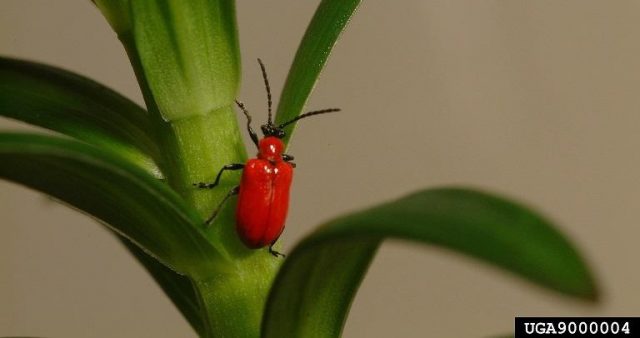Beetles attack Asiatic lilies (Lilium sp.), Fritillaria, Oriental hybrids – have you seen these on your Asiatic lillies?
 The LLB is a red colored beetle with a black underside and is about half inch in length. The beetle is very quick and sometimes will make a squeak if disturbed. (Bugwood.org)
The LLB is a red colored beetle with a black underside and is about half inch in length. The beetle is very quick and sometimes will make a squeak if disturbed. (Bugwood.org)
BELMONT, N.Y. — Yes it is true the Lilly Leaf Beetle (Lilioceris lilii) is now in New York State. Specifically, the beetles attack Asiatic lilies (Lilium sp.) and Fritillaria but will also attack Oriental hybrids. LLB adults may feed on and cause minor damage to a few other herbaceous plants such as Solomon’s seal and flowering tobacco, but they do not reproduce on these plants. First introduced to Canada sometime in 1942 it has slowly spread south being found in Boston, Ma. in 1992, New England states in 1997 and now confirmed in New York. The LLB is a red colored beetle with a black underside and is about half inch in length. The beetle is very quick and sometimes will make a squeak if disturbed. The adult beetles stay alive throughout the winter and emerge early in the spring, when they begin looking for food and mates. The adult females lay their eggs on the underside of lily and solanum leaves and produce between 250 and 450 eggs. The eggs appear in April or May and hatch within eight days. (photo Carol Sitarski: holes in lily plant from lily leaf beetle feeding)
At first they are orange in color than become tan. The larvae which are an orange color eat the leaves and buds voraciously and hide from predators inside a glob of dark green excrement called a fecal shield. The feeding period lasts 16-to-24 days. From there, the larvae drop to the soil and pupate, emerging as adults about 16-to-22 days later. They feed throughout the rest of the growing season.
How can you control this invasive beetle in your home garden? At this time there is no reliable insecticide other than Neem oil, which does provide some protection if applied every 5-7 days when eggs begin to hatch. Synthetic systemic control use is not recommended due to its possible link to bee colony collapse. The best control method is non-chemical: hand-picking adults, eggs, and larvae is an effective means of reducing damage to your plants. It’s important to begin scouting for emergence of adults in April, and destroy any that you see. As spring progresses, check the undersides of leaves for orange egg masses and destroy them as well. Remove young larvae from leaves as they develop. Wear a tight-fitting rubber glove if you want to avoid directly touching the eggs or larvae. Make this practice a regular routine throughout the summer months, as it is a very effective control tactic. There is research being done with parasitic wasps that will hopefully help out the situation in years to come.
–Carol Sitarski, Master Gardener
Cornell Cooperative Extension Allegany County
